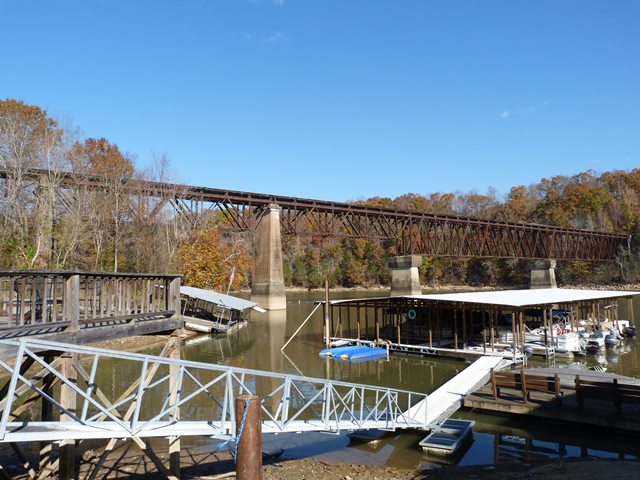We Recommend:
Bach Steel - Experts at historic truss bridge restoration.
BridgeHunter.com Phase 1 is released to the public! - Visit Now
Rock Island Railroad Bridge

Primary Photographer(s): Nathan Holth
Bridge Documented: November 11, 2014
Rock Island: Warren County, Tennessee and White County, Tennessee: United States
Metal 7 Panel Pin-Connected Warren Deck Truss, Fixed and Approach Spans: Metal 2 Panel Pin-Connected Kingpost Deck Truss, Fixed
1872 By Builder/Contractor: Louisville Bridge and Iron Company of Louisville, Kentucky
1922
210.0 Feet (64 Meters)
Not Available
Not Available
4 Main Span(s)
Not Applicable

View Information About HSR Ratings
Bridge Documentation
This bridge has multiple areas of high significance, which combine to make it one of the most significant railroad bridges in the state. First, the bridge's main spans are rare examples of pin-connected Warren trusses. Pratt trusses were far more common than Warren trusses during the pin-connected era. Warren trusses became popular only after the riveted connection was popular. This bridge's Warren truss spans are configured as two larger spans which are arranged so that the bridge bears on short piers at the bottom chord, and two shorter spans which bear on tall piers at the top chord.
Another notable detail of the Warren trusses is that a third truss line was added to this bridge at a later date in between the original truss lines which would have strengthened the bridge. The third truss line is of heavier construction, indicating its newer construction, but is riveted and uses pin-connections, indicating this is a very old alteration, such that the alteration itself has historic significance.
As rare as the Warren truss spans are, the bridge's approach spans are even more rare and are pin-connected Kingpost deck truss spans. The Kingpost truss configuration is one of the rarest truss configurations among surviving bridges, and it is usually found on highway bridges and as a pony truss. As such, the railroad deck truss Kingpost spans are doubly rare. Frustratingly, these spans are absolutely buried behind trees and are hard to view and photograph even in the winter.
The Kingpost spans did not appear to have a third truss line added like the Warren truss spans.
Although the construction date is not known, this appears to be a very old (1880s?) railroad truss bridge. The unusual truss configuration and lightweight members are one indication of this.
This bridge's main spans including addition of a third truss line are similar to Big Hickory Creek Railroad Bridge

![]()
Photo Galleries and Videos: Rock Island Railroad Bridge
Bridge Photo-Documentation
Original / Full Size PhotosA collection of overview and detail photos. This gallery offers photos in the highest available resolution and file size in a touch-friendly popup viewer.
Alternatively, Browse Without Using Viewer
![]()
Bridge Photo-Documentation
Mobile Optimized PhotosA collection of overview and detail photos. This gallery features data-friendly, fast-loading photos in a touch-friendly popup viewer.
Alternatively, Browse Without Using Viewer
![]()
Maps and Links: Rock Island Railroad Bridge
Coordinates (Latitude, Longitude):
Search For Additional Bridge Listings:
Bridgehunter.com: View listed bridges within 0.5 miles (0.8 kilometers) of this bridge.
Bridgehunter.com: View listed bridges within 10 miles (16 kilometers) of this bridge.
Additional Maps:
Google Streetview (If Available)
GeoHack (Additional Links and Coordinates)
Apple Maps (Via DuckDuckGo Search)
Apple Maps (Apple devices only)
Android: Open Location In Your Map or GPS App
Flickr Gallery (Find Nearby Photos)
Wikimedia Commons (Find Nearby Photos)
Directions Via Sygic For Android
Directions Via Sygic For iOS and Android Dolphin Browser
USGS National Map (United States Only)
Historical USGS Topo Maps (United States Only)
Historic Aerials (United States Only)
CalTopo Maps (United States Only)

